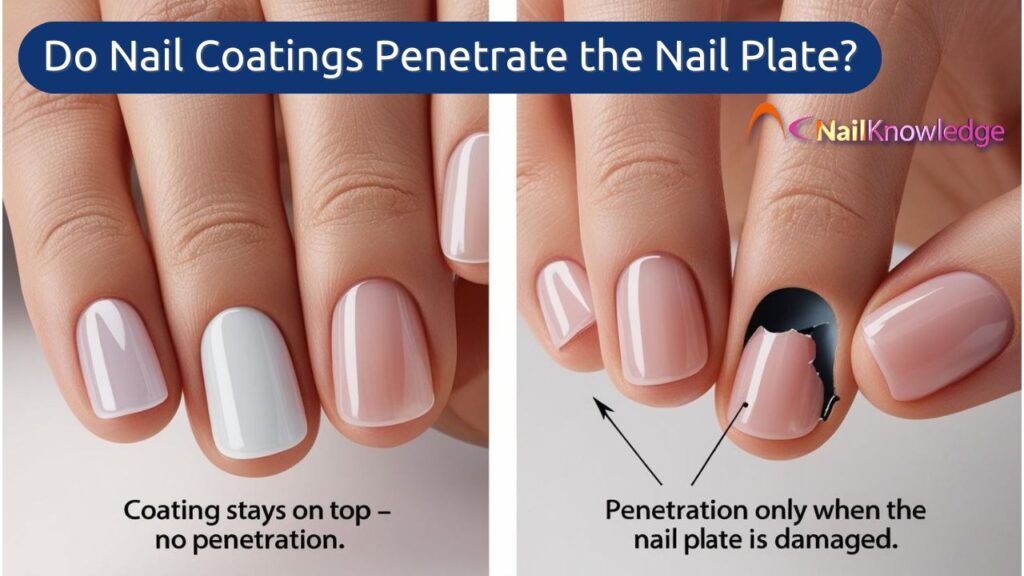We’ve all heard the chatter on social, in salons, maybe even whispered in the corner of a nail tech class. “Gels seep into the nail bed.” “Acrylics cause lifting from the inside out.” But hold up, Isso é realmente verdade? If you’ve ever paused mid-mani and wondered, Do nail coatings penetrate the nail plate?, you’re not alone. This question has sparked confusion, myths, and worry for nail enthusiasts and pros alike.
So let’s break it down together, science meets real talk style.
O que mesmo É a placa ungueal?
Before we get into the juicy myth-busting, let’s take a hot second to appreciate the nail plate. Think of it like a security guard for your leito ungueal, it’s strong, smart, and surprisingly picky about what it lets through.
The nail plate is the visible, hard part of your nail. It’s made up of tightly packed keratin cells (like your hair, but flatter and harder) and acts as a natural barrier, guarding the sensitive nail bed beneath from outside elements, including chemicals. But here’s the wild part, it’s semipermeável. Ele permite água passam facilmente, mas quase todo o resto? Boa sorte ao passar por essa parede de queratina.
Até mesmo os óleos para unhas, sim, os bons que você aplica religiosamente, têm dificuldade para ir além da superfície. Estudos mostram que eles precisam um mês ou mais de aplicação diária just to reach the top 10% of the plate. That’s persistence!
Os revestimentos de unhas penetram na placa ungueal?
Spoiler: Não em unhas saudáveis.
Let’s get to the heart of it: Os revestimentos de unhas penetram na placa ungueal?
A resposta curta? Não. Não se a placa ungueal estiver intacta e saudável.
Whether it’s UV gels, builder in a bottle, dip powders, or acrylic overlays, they all sit on superior of the nail plate. They’re designed to adhere to the surface, not sink into it. The myth that they burrow down to the nail bed and wreak havoc? That’s more fiction than fact.
Onycholysis, the term for when the nail lifts from the bed does happen, but coatings aren’t the villain in a typical scenario. The real culprits? Things like:
- Preenchimento excessivo da placa ungueal
- Usar muita pressão ao preparar
- Harsh trauma (hello, stiletto nail stub!)
- Certos medicamentos ou problemas de saúde
In other words, it’s not the product going rogue, it’s usually what’s done antes de ou em torno de o produto que causa problemas.
Mas o quê? Se A placa ungueal está danificada?
Now, let’s be real. Not all As placas de unha estão em perfeitas condições. We’ve all been there, peeling off gel (don’t judge), over-filing to remove a stubborn top coat, or dealing with breakage. So what happens if the nail plate is rachado, quebradoou arquivado muito fino?
That’s when things get a little dicey.
When the nail plate’s natural barrier is compromised, the coatings you apply could potencialmente reach the skin underneath. That exposure might lead to irritation, allergic reactions, or in rare cases, trigger onycholysis. Think of it like a roof with a hole, water wasn’t a problem before, but now the couch is soaked.
The key takeaway? If the nail plate is damaged, even the most gentle product can cause a reaction, not because it’s inherently “bad,” but because it’s going somewhere it was never supposed to go.
Revestimentos de pregos = Jogadores de superfície, não mergulhadores profundos
Let’s go back to basics: Coatings are designed to be no topo. They bond with the surface keratin, not beneath it. They’re like the perfect topcoat to a stylish outfit. Decorative? Absolutely. Protective? Often. But invasive? Nope.
When people say, “This product caused damage,” what they often mean is:
- A preparação foi muito agressiva.
- The removal process wasn’t gentle.
- As unhas já estavam comprometidas antes da aplicação do produto.
The product didn’t tunnel its way to the nail bed like a villain in a spy movie, it just did what it was told, on the surface.
Unhas saudáveis = Revestimentos felizes
Então, como podemos manter as boas vibrações entre nossas unhas e nossos produtos favoritos?
- Evite o arquivamento excessivo. Mantenha essa camada protetora forte e feliz.
- Mantenha as unhas saudáveis. Don’t apply coatings to damaged, inflamed, or thinning nails.
- Seja paciente com a remoção. Cautiously soak, rebalance but don’t rip.
- Hidrate suas unhas. Even if oils don’t go deep, they help prevent brittleness and keep the top layers flexible.
Proteger a integridade da lâmina ungueal significa dar aos seus revestimentos a melhor superfície para brilhar, literal e figurativamente.
Considerações finais: Conheça a verdade, acerte em cheio
Let’s wrap this up like a glossy topcoat:
Os revestimentos de unhas penetram na placa ungueal? Não, a menos que a placa ungueal tenha sido comprometida (o que é fácil de acontecer). Portanto, quando usados adequadamente, com uma boa preparação e unhas saudáveis, seus géis, acrílicos e sobreposições são uma beleza de nível superficial, não invasores secretos.
So the next time someone tells you that gel “seeps into your nail bed,” you can raise an eyebrow and say, “Actually, that’s not how the nail plate works.” 💁♀️
💅 Dica de unha do dia:
If you wouldn’t sand your skin, don’t sand your nails. Um toque suave = unhas mais fortes e manicure mais duradouro.


